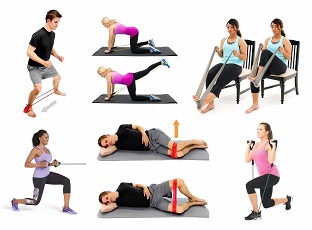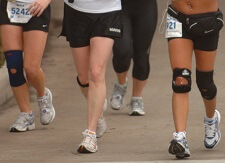- Home
- Knee Symptoms
- Knee Pain Squatting
Knee Pain When Squatting
Written By: Chloe Wilson, BSc(Hons) Physiotherapy
Reviewed by: KPE Medical Review Board
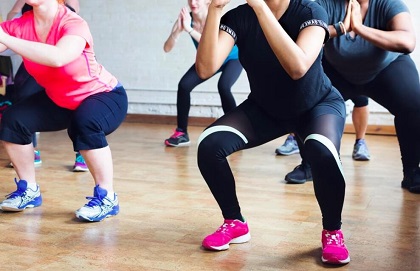
Knee pain when squatting is a common but avoidable problem.
There is a common misconception that squatting is bad for your knees, but that just simply isn’t true. When done correctly, squatting is actually really good for you!
Indeed, in many countries, squatting is a common resting position so it can't be all bad.
Squatting is rarely the primary cause of knee pain, but often exacerbates underlying knee problems. Here we will look at the ten most common causes of knee pain from squatting, how to treat and prevent them and how to make sure you are using the best technique when you squat.
What Causes Knee Pain When Squatting?
Our bodies are designed to be able to squat without knee pain. The key to pain-free squatting is a combination of good muscle strength, adequate flexibility, a healthy joint and good technique. Anything that affects any of these can cause pain.
The ten most common causes of knee pain when squatting are:
1. Cartilage Tear
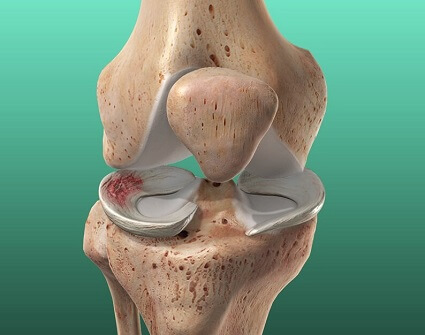
The most common injury to cause knee pain when squatting is a meniscus tear. This is where there is damage to the special cartilage that lines the knee joint.
A great deal of force goes through the knee when we squat, and the cartilage works like a natural shock absorber to help to protect the knee joint.
So if the cartilage gets damaged, more of that pressure goes through the knee bones when squatting, which can cause irritation, swelling and pain.
Sharp knee pain when squatting is common with cartilage injuries and people often experience a catching or locking sensation in the knee when they squat down. The deeper the squat, the worse the pain typically.
Find out more about the causes, symptoms and treatment options in the Meniscus Tear section.
2. Knee Bursitis
A common cause of knee pain when squatting that is accompanied by localised swelling in knee buritis.
Around the knee are a number of small fluid-filled sacs known as bursa. They work to cushion and protect the structures surrounding the knee by reducing tension on structures such as ligaments and tendons as the knee moves.
Repetitive overloading or friction can cause the knee bursa to become inflamed, causing excess fluid to collect in the bursa leading to a soft pocket of localised swelling.
There are a number of different bursa located around the knee that can caused knee pain when squatting:
- Suprapatellar Bursa: located just above the kneecap in the lower thigh
- Prepatellar Bursa: located right in front of the kneecap
- Infrapatellar Bursa: located just below the kneecap on the front of the shin
- Semimembranosus Bursa: located at the back of the knee
Find out more about the causes, symptoms, diagnosis and treatment options in the knee bursitis section.
3. Poor Technique
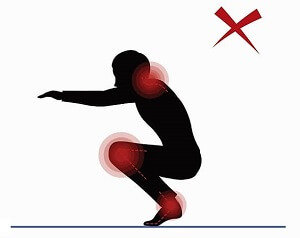
Poor technique is another common causes of knee pain when squatting.
If the hips, knees or ankles are in the wrong position when squatting, particularly with deep squats, then knee joint gets overloaded. Excess pressure goes through part of the knee which can lead to repetitive friction and gradual wear and tear.
Good technique is particularly important if you are using weights when you squat as part of your workout routine, as holding weights when you squat increases the forces through the knee.
There's loads of great advice on how to squat properly without overloading your knee further down the page so keep reading.
4. Weak Glutes
In my experience, almost everyone I’ve seen complaining of knee pain when squatting has weak gluteal muscles.
The glutes play a massive role in supporting the knee joint and ensuring the forces are equally distributed through the joint when you squat. If the glutes are weak, the knee cannot track properly and gets overloaded, resulting in knee pain during and after squatting.
The good news is, there are some really simple exercises that you can do to build up your glutes strength and in turn reduce your knee pain when squatting - visit the glutes strengthening exercises section to find out more.
5. Runners Knee
Runners Knee, aka PFPS (Patellofemoral Pain Syndrome), is another common cause of knee pain when squatting. With Runners Knee, there is a problem with how the kneecap moves. This causes irritation of the cartilage on the back of the kneecap resulting in inflammation and wear and tear.
A lot of force goes through the kneecap when you squat, so the irritation in the cartilage associated with runners knee can make it really painful to squat.
The symptoms of Runners Knee tend to come and go, are typically worse after prolonged rest or long periods of exercise, and sufferers often experience clicking/grinding sensations when moving their knee.
Find out more about the common causes, symptoms, diagnosis and treatment options in the Runners Knee section.
6. Chondromalacia Patella
Chondromalacia patella is one of the most common causes of knee pain when squatting in young, healthy individuals. With chondromalacia there is softening of the cartilage that lines the back of the kneecap.
People with chondromalacia patella typically complain of a dull, achy pain at the front of their knee and a grinding sensation when they squat rather than a sharp, stabbing pain.
Chondromalacia patella is one of those conditions that people tend to grow out of so if you are over 30 and have knee pain when squatting, it's unlikely to be the cause. But if you are under 20, there's a high chance that's what's going on.
You can find out loads more about the causes, symptoms and treatment options in the chondromalacia patella section.
7. Patellar Tendonitis
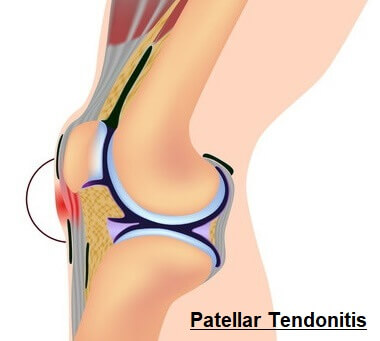
With patellar tendonitis, aka Jumpers Knee, there is damage to the patellar tendon, found just below the kneecap.
Repetitive forces through the tendon from activities such as frequent jumping and kicking, leads to inflammation and tearing of the tendon.
This tendon irritation results in pain any time the knee bends, particularly when taking weight through the knee, resulting in knee pain when squatting.
Without effective treatment, the symptoms of patellar tendonitis gradually get worse over time, increasing in frequency, intensity and duration.
You can find out lots more about the common causes, symptoms and treatment options in the jumpers knee section.
8. Iliotibial Band Syndrome (ITBS)
Pain on the outer side of the knee when squatting is often due to iliotibial band syndrome.
With ITBS, there is irritation of the thick band running down the outer thigh to the knee. Tightness in the band pulls on the kneecap, bringing it slightly out of position. This leads to excess friction and force through the kneecap when bending the knee, resulting in knee pain when squatting.
The pain from iliotibial band syndrome tends to be on the outer side of the knee and may be accompanied by a popping/snapping sensation. ITBS most commonly affects runners.
Find out more about the common causes, symptoms and treatment options in the iliotibial band syndrome section.
9. Knee Arthritis
Knee arthritis is the most common cause of knee pain squatting in people over the age of 60. Wear and tear of the knee cartilage and bones associated with arthritis can make squatting very painful.
With knee arthritis there is less cushioning and space between the knee bones due to wear and tear. When you squat down, the cartilage gets squashed and the bones rub on each other which can cause a lot of pain. Knee arthritis tends to affect the inner side of the knee more than the outer side of the knee, but you may experience knee pain anywhere in the knee when you squat with arthritis.
Find out all about the common causes, symptoms, diagnosis and treatment options in the Knee Arthritis section.
10. Hamstring Injuries
If you get pain in the back of your thigh or posterior knee pain when squatting it may be due to a hamstring injury. The hamstrings are a group of three muscles on the back of the thigh that run between the pelvis and the shin bones, that work to bend the hip and extend the knee.
Two common hamstring injuries that can lead to posterior thigh and knee pain when suqatting are:
- Pulled Hamstring: Sudden overstretching or overloading of the hamstrings can lead to tearing of some or all of the muscle fibres. Hamstrings strains are the most frequent injuries seen in sports
- Hamstring Tendonitis: Repetitive loading or friction through the hamstring tendons leads to inflammation and degeneration of the tendons
Hamstring injuries typically affect athletes who do lots of sprinting, pivoting movements, kicking and jumping.
You can find out all about the causes, symptoms, diagnosis and treatment options for knee pain when squatting from hamstring injuries in the Hamstring Strains and Hamstring Tendonitis sections.
Treatment And Prevention
The best way to treat knee pain from squatting is with a combination of:
1. RICE Treatment
RICE treatment stands for rest, ice, compression and elevation and is a great place to start when treating knee pain from squatting.
- Rest: the knee and avoid activities that cause knee pain, especially squats
- Ice: regularly apply a wrapped ice pack to the knee for 15 minutes to reduce pain and inflammation
- Compression: Reduce swelling and support the knee with tubigrip compression bandage
- Elevation: When resting, prop your leg up on pillows to help reduce swelling. Aim to get your knee higher than your heart
2. Medication
Over the counter pain relief and non-steroidal anti-inflammatories help to reduce pain and inflammation in the knee from squats. This can be particularly helpful if pain is limiting how much you can exercise
3. Strengthening Exercises
Strengthening the muscles around the knee, particularly the glutes, are one of the best ways to prevent knee pain when squatting. In most cases, after 4-8 weeks of daily strengthening exercises for the knee muscles and glutes, people find they can do full squats without any knee pain.
You can find a whole range of exercises that can help in the knee strengthening exercises section - they are a must for anyone who gets knee pain when they squat.
4. Increasing Flexibility
Improving knee flexibility can really help reduce knee pain when squatting. If there is any stiffness or tightness in the hip, knee or ankle joints or muscles, it changes how the forces go through the knee, so having normal knee range of motion is vital.
If there is any muscle tightness, it can change how the kneecap moves and squash it against the knee joint which leads to pain.
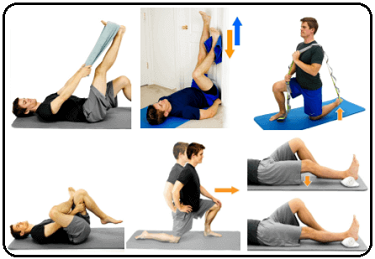
Stretches help to ensure normal biomechanical function at the knee, reducing pressure through the joint.
Knee stretches, particularly ones that target the quads and hamstrings help to reduce and tightness and friction and make it easier to squat.
But it is really important to always work on strength exercises first. Muscle tightness is often the bodies way of providing stability to a weak joint. You don’t want to take away that stability until you’ve replaced it otherwise you will end up in more pain!
How To Do The Perfect Squat
Without the right technique, knee pain when squatting can be a real problem, particularly if you are using weights or doing deep squats. But making a few small adjustments really can make all the difference. Anyone doing squats as part of their workout problem should be aware of their technique.
Best Standing Squats Technique
So let’s look at how to perform the perfect squat:
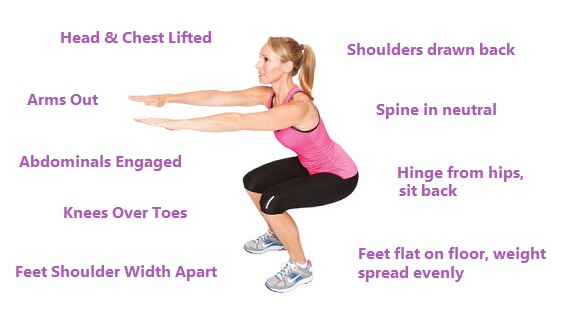
- Stand with your knees hip width apart. Hips, knees and toes should be pointing forwards. TOP TIP: To get the right distance, start with your feet together, turn your toes out to form a “V” and then follow the movement with your heels so they are in-line with your toes
- Ensure your weight is spread evenly through your feet: TOP TIP - Imagine 3 points under your foot: one under the base of your big toe, one under the base of your little toe and one under the middle of your heel. Gently rock backwards and forwards a few times and come to rest with your weight spread evenly between those 3 points
- Take a deep breath in and as you breathe out start to squat: Bend at the hips and knees and squat down, taking your bottom backwards as if you were going to sit in a chair
- Check Your Knee Position: Keep your knees behind your toes and make sure you keep your knees apart - don’t let them drop inwards. TOP TIP: Look down and check your knee is in-line with your second toe - you should always be able to see your big toe as you squat
- Keep your heels down: Ensure your weight stays evenly spread through your foot to avoid excess force through the kneecap
- Check your upper body position: Keep looking forwards with your head upright, spine in neutral, chest lifted and shoulders drawn back gently. Some people find it helps to lift both arms forwards as they squat down to help them balance
- Don’t squat down too far: You shouldn’t feel any pain when you squat – if you do, reduce the depth of the squat. Never let your bottom drop lower than your knees
- Use A Mirror: Doing squats in front of the mirror helps to ensure you maintain good position and form throughout the movement
- Hold the squat for 2-3 seconds: If comfortable - remember, there shouldn’t be any pain in your knees
- To come back up: inhale, tighten your abdominal muscles, clench your buttocks together, push down through your heels and slowly rise to the starting position
- Gradually Increase Your Repetitions: Start with one set of 10 repetitions. Once you are happy with that, try increasing to 2 sets of 10 reps, and finally build up to 3 sets of 10 reps
Best Wall Squats Technique
If you are recovering from a knee injury, have arthritis or find you are still getting knee pain when squatting, try these wall squats instead. The wall provides some support which helps to reduce the forces going through the knees, and makes it easier to balance and stay in good alignment.
To perform wall squats correctly:
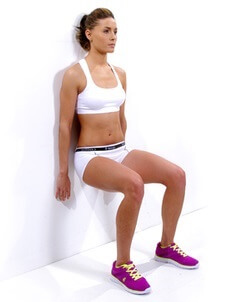
- Stand With Your Back Against a Wall: Your heels should be around 18 inches from the wall, feet hip width apart as described above
- Take A Breath In and As You Exhale, Gently Slide Down The Wall: keep your back and buttocks in contact with the wall
- Make Sure Your Knees Don’t Drop Inwards: remember to keep them in-line with your second toe – have a quick peek down to make sure you can still see your big toe
- Lower Down As Far As Feels Comfortable: Don’t let your buttocks drop lower than your knees and if you can, try and hold the squat position for a couple of seconds
- To Come Back Up: breathe in, draw in your abdominal muscles, push down through your heels, clench you buttock muscles and slowly slide back up the wall
- Start With One Set of 10 repetitions: once you are happy with that, try increasing to 2 sets of 10 reps, and finally build up to 3 sets of 10 reps
Recovery
Most people suffering from knee pain when squatting find that their symptoms start to settle down within a few weeks using the treatments we have talked about here. If however your symptoms persist you, talk to your doctor.
Other things that can help if you get knee pain from squatting include:
- Changing Your Activities: opt for low impact exercise such as swimming or cycling, and avoid activities that aggravate your knee
- Warm Up & Cool Down: Whenever exercising or playing sports
- Ensure Healthy Weight: Losing weight helps to reduce the forces through the knees, but is only indicated if you are overweight
- Regular Strengthening & Stretching Exercises: These help to prevent muscle imbalance. Visit the knee strengthening and knee stretches sections to find the right exercises for you
- Orthotics: If you have flat feet or valgus knees, then shoe inserts from a podiatrist can help to correct lower limb alignment
- Physical Therapy: A PT can assess the cause of your knee pain when squatting and work on a rehab programme with you
If your pain from squats continues to get worse or is accompanied by knee locking or giving way, you may need to have arthroscopic (keyhole) knee surgery.
Common Questions About Squats
1. What Are The Benefits Of Squatting?
1. What Are The Benefits Of Squatting?
There are a whole host of benefits of squatting:
- Improves Muscle Strength & Function: in the calves, hamstrings, quadriceps, abdominals and back muscles
- Improves Balance: particularly helpful as you get older
- Help Prevent Injuries: by improving strength, flexibility, balance and joint health
- Improves Bone Strength: Weight-bearing exercises help improve bone density
- Improves Health & Fitness: Performing fast sets of squats, especially if using weights, can help to improve fitness levels, burn calories and reduce body weight
- Improves Posture: Another benefit of squatting is that it increases core stability which in turns helps to improve overall body posture
- Makes Daily Activities Easier: such as getting in and out of a chair or bed
2. Why Do My Knees Crack When Squatting?
2. Why Do My Knees Crack When Squatting?
There are a number of possible reasons why knees crack when squatting. If the cracking noise is accompanied by knee pain, it is most likely due to a cartilage injury or arthritis.
Often knees crack when squatting without there being any pain, which is usually due to gas bubbles in the joint popping. Visit the knee pain and popping section to find out more.
3. What Causes Knee Pain After Squatting?
3. What Causes Knee Pain After Squatting?
If you get knee pain after squatting down rather than during squatting, chances are you are overworking your knee. There is most likely a problem with muscle strength and endurance and as the muscles fatigue, they are unable to provide adequate support to the knee, resulting in pain.
Knee pain after squatting could also be the result of a minor injury inside the knee such as a small cartilage tear. Performing squats may be irritating the joint slightly causing a slow build of inflammation that continues to build once after you’ve finished squatting, resulting in delayed onset knee pain.
Knee Pain When Squatting Summary
If you are suffering from knee pain when squatting, don’t lose heart. Chances are, things will improve with a combination of knee exercises and changing your technique.
Don’t be afraid to squat – our bodies are designed to do it, and in fact, being able to squat is really important when it comes to lifting heavy objects so that there is minimal strain on your lower back.
Listen to your body – if you are getting knee pain when squatting, don’t try and push through it. No pain no gain does not apply here. Take things a bit easier, let the pain settle down then work on a home exercise programme to strengthen the leg muscle and you should find yourself back to pain-free squatting before you know it.
You might also be interested in the following articles:
- Knee Pain & Popping
- Swollen Knee Treatment
- Front Knee Pain
- Pain Above Knee
- Side Knee Pain
- Burning Knee Pain
- Knee Range Of Motion
- Knee Pain On Stairs
Related Articles
References
1. The Lowdown On Squats. Harvard Health Publishing. March 2019
2. Reasons For Knee Pain With Full Squats. Livestrong. April 2019
3. How To Squats Correctly. Arthritis Foundation
Page Last Updated: 09/05/2024
Next Review Due: 09/05/2026
